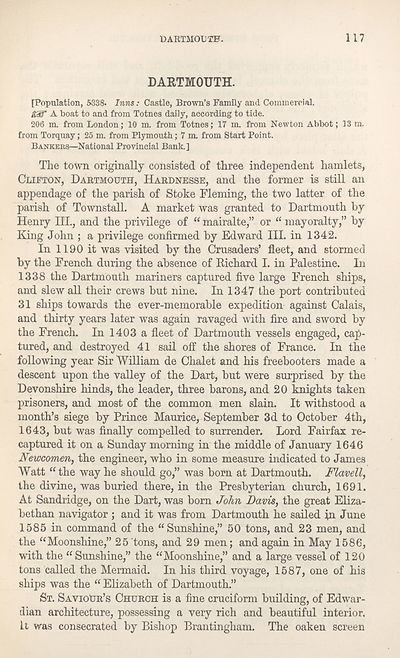Download files
Complete book:
Individual page:
Thumbnail gallery: Grid view | List view

DARTMOUTH.
117
DARTMOUTH.
[Population, 5338- Inns: Castle, Brown’s Family and Commercial.
SStT A boat to and from Totnes daily, according to tide.
206 m. from London; 10 m. from Totnes; 17 m. from Newton Abbot; 13 m.
from Torquay; 25 m. from Plymouth; 7 m. from Start Point.
Bankers—National Provincial Bank.]
The town originally consisted of three independent hamlets,
Clifton, Dartmouth, Hardnesse, and the former is still an
appendage of the parish of Stoke Fleming, the two latter of the
parish of Townstall. A market was granted to Dartmouth by
Henry III., and the privilege of “ mairalte,” or “ mayoralty,” by
King John ; a privilege confirmed by Edward III. in 1342.
In 1190 it was visited by the Crusaders’ fleet, and stormed
by the French during the absence of Richard I. in Palestine. In
1338 the Dartmouth mariners captured five large French ships,
and slew all their crews but nine. In 1347 the port contributed
31 ships towards the ever-memorable expedition against Calais,
and thirty years later was again ravaged with fire and sword by
the French. In 1403 a fleet of Dartmouth vessels engaged, cap¬
tured, and destroyed 41 sail off the shores of France. In the
following year Sir William de Chalet and his freebooters made a
descent upon the valley of the Dart, but were surprised by the
Devonshire hinds, the leader, three barons, and 20 knights taken
prisoners, and most of the common men slain. It withstood a
month’s siege by Prince Maurice, September 3d to October 4th,
1643, but was finally compelled to surrender. Lord Fairfax re¬
captured it on a Sunday morning in the middle of January 1646
Newcomen, the engineer, who in some measure indicated to James
Watt “the way he should go,” was born at Dartmouth. Flavell,
the divine, was buried there, in the Presbyterian church, 1691.
At Sandridge, on the Dart, was bom John Davis, the great Eliza¬
bethan navigator; and it was from Dartmouth he sailed jn June
1585 in command of the “Sunshine,” 50 tons, and 23 men, and
the “Moonshine,” 25 tons, and 29 men; and again in May 1586,
with the “ Sunshine,” the “Moonshine,” and a large vessel of 120
tons called the Mermaid. In his third voyage, 1587, one of his
ships was the “ Elizabeth of Dartmouth.”
St. Saviour’s Church is a fine cruciform building, of Edwar¬
dian architecture, possessing a very rich and beautiful interior.
It was consecrated by Bishop Brantingham. The oaken screen
117
DARTMOUTH.
[Population, 5338- Inns: Castle, Brown’s Family and Commercial.
SStT A boat to and from Totnes daily, according to tide.
206 m. from London; 10 m. from Totnes; 17 m. from Newton Abbot; 13 m.
from Torquay; 25 m. from Plymouth; 7 m. from Start Point.
Bankers—National Provincial Bank.]
The town originally consisted of three independent hamlets,
Clifton, Dartmouth, Hardnesse, and the former is still an
appendage of the parish of Stoke Fleming, the two latter of the
parish of Townstall. A market was granted to Dartmouth by
Henry III., and the privilege of “ mairalte,” or “ mayoralty,” by
King John ; a privilege confirmed by Edward III. in 1342.
In 1190 it was visited by the Crusaders’ fleet, and stormed
by the French during the absence of Richard I. in Palestine. In
1338 the Dartmouth mariners captured five large French ships,
and slew all their crews but nine. In 1347 the port contributed
31 ships towards the ever-memorable expedition against Calais,
and thirty years later was again ravaged with fire and sword by
the French. In 1403 a fleet of Dartmouth vessels engaged, cap¬
tured, and destroyed 41 sail off the shores of France. In the
following year Sir William de Chalet and his freebooters made a
descent upon the valley of the Dart, but were surprised by the
Devonshire hinds, the leader, three barons, and 20 knights taken
prisoners, and most of the common men slain. It withstood a
month’s siege by Prince Maurice, September 3d to October 4th,
1643, but was finally compelled to surrender. Lord Fairfax re¬
captured it on a Sunday morning in the middle of January 1646
Newcomen, the engineer, who in some measure indicated to James
Watt “the way he should go,” was born at Dartmouth. Flavell,
the divine, was buried there, in the Presbyterian church, 1691.
At Sandridge, on the Dart, was bom John Davis, the great Eliza¬
bethan navigator; and it was from Dartmouth he sailed jn June
1585 in command of the “Sunshine,” 50 tons, and 23 men, and
the “Moonshine,” 25 tons, and 29 men; and again in May 1586,
with the “ Sunshine,” the “Moonshine,” and a large vessel of 120
tons called the Mermaid. In his third voyage, 1587, one of his
ships was the “ Elizabeth of Dartmouth.”
St. Saviour’s Church is a fine cruciform building, of Edwar¬
dian architecture, possessing a very rich and beautiful interior.
It was consecrated by Bishop Brantingham. The oaken screen
Set display mode to:
![]() Universal Viewer |
Universal Viewer | ![]() Mirador |
Large image | Transcription
Mirador |
Large image | Transcription
| Antiquarian books of Scotland > Adventure and adventurers > Black's guide to the counties of Dorset, Devon, & Cornwall > (145) |
|---|
| Permanent URL | https://digital.nls.uk/142588118 |
|---|
| Description | Thousands of printed books from the Antiquarian Books of Scotland collection which dates from 1641 to the 1980s. The collection consists of 14,800 books which were published in Scotland or have a Scottish connection, e.g. through the author, printer or owner. Subjects covered include sport, education, diseases, adventure, occupations, Jacobites, politics and religion. Among the 29 languages represented are English, Gaelic, Italian, French, Russian and Swedish. |
|---|

